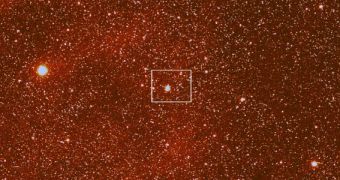Officials with the European Space Agency (ESA) have announced that the Rosetta spacecraft was recently able to observe its target, comet 67P/Churyumov–Gerasimenko, for the first time since launching into space on March 2, 2004. The probe exited its hibernation mode earlier this year, on January 20, and it has been commissioning its scientific instruments ever since.
As part of these efforts, the Optical, Spectroscopic, and Infrared Remote Imaging System (OSIRIS) was also activated and scientists at ESA were able to use it to photograph the incoming comet on March 20 and 21. This was made possible by the fact that OSIRIS features both wide- and narrow-angle cameras.
These first-light images are not very detailed, since the celestial object is still a good distance away from Rosetta. However, researchers were able to identify the fast-moving comet in the night sky. This effort was part of a series of activities meant to ready the spacecraft for its encounter a month from now. The entire process will last for about 6 weeks.
OSIRIS was developed by engineers at Max Planck Institute for Solar System Research in Göttingen, Germany, who installed a lower-resolution, wide-angle camera and a high-resolution, narrow-angle camera on the instrument. This will allow the device to collect very relevant images of its target.
“Finally seeing our target after a 10 year journey through space is an incredible feeling. These first images taken from such a huge distance show us that OSIRIS is ready for the upcoming adventure,” says MPI-SSR expert Holger Sierks, the principal investigator for the OSIRIS instrument.
“This is a great start to our instrument commissioning period and we are looking forward to having all 11 instruments plus lander Philae back online and ready for arriving at the comet in just a few months’ time,” adds Rosetta project scientist Matt Taylor, who holds an appointment with ESA.
The 11 scientific instruments on Rosetta will target a variety of aspects related to the composition and behavior of comet 67P/Churyumov–Gerasimenko, including its internal structure, actual shape, mass, plasma environment, surface geology, gravitational pull, and its extremely dust-rich atmosphere.
Included aboard Rosetta is the Philae robotic lander, a smaller spacecraft that will separate from the probe and fall towards the surface of the comet on a ballistic trajectory. The smaller vehicle will then use grappling hooks to latch onto the surface and will employ its 10 scientific instruments to analyze the geology of the object. The data it produces will be sent to Rosetta, and then relayed to Earth.
At this point, Philae is scheduled to be launched from Rosetta in November 2014, though a clear date has yet to be established. Its primary mission may last anywhere from 1 to 6 weeks, depending on the conditions it encounters on the surface of 67P/Churyumov–Gerasimenko. This is the first robot to ever land on the surface of comet.

 14 DAY TRIAL //
14 DAY TRIAL //